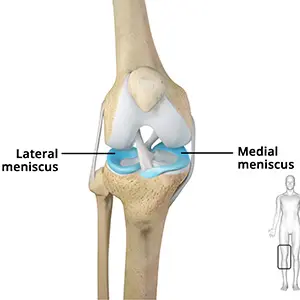Navigating Meniscectomy: Procedure, Recovery, and Insights
In the realm of orthopedic surgery, meniscectomy emerges as a crucial procedure for addressing meniscus tears, a prevalent knee injury. This comprehensive guide aims to demystify meniscectomy, elucidating the procedure, recovery nuances, and key insights to empower patients and healthcare practitioners alike.

What is Meniscectomy?
At its core, meniscectomy is a surgical intervention meticulously designed to rectify meniscus tears, commonly occurring knee injuries. The meniscus, acting as a vital cushioning and stabilizing structure within the knee joint, can sustain tears due to traumatic incidents or gradual wear and tear. This procedure, therefore, plays a pivotal role in restoring knee health and function.
Symptoms and Diagnosis of Meniscus Tears
Recognizing the signs of meniscus tears proves essential for timely intervention. Individuals might experience persistent knee pain, swelling, and stiffness, often accompanied by a noticeable decrease in joint flexibility. Moreover, the knee joint might intermittently lock, causing discomfort during movement. Skilled orthopedic practitioners employ a combination of physical examinations, imaging technologies such as MRI, and other diagnostic methods to pinpoint meniscus tears accurately.
The Meniscectomy Procedure
The intricacies of the meniscectomy procedure are noteworthy. Typically conducted through minimally invasive arthroscopic techniques, the surgeon accesses the knee joint through small incisions. Employing specialized instruments and guided by advanced imaging, the torn portion of the meniscus is meticulously excised. This surgical precision contributes to reduced post-operative pain, quicker recovery times, and improved overall outcomes. In this era of technological advancements, the integration of Natural Language Processing (NLP) augments surgical planning and decision-making, enhancing the precision and effectiveness of meniscectomies.
Recovery and Rehabilitation
Following a meniscectomy, a structured recovery process is imperative to ensure optimal healing and restoration of knee function. Pain management and swelling reduction strategies are commonly employed during the initial stages. Physical therapy plays a pivotal role in gradually reintroducing movement and strengthening exercises. Engaging in a comprehensive rehabilitation program aids in restoring knee flexibility and overall joint stability. However, it’s crucial to strike a balance, avoiding excessive strain that could impede the healing process.
Alternative Approaches and Future Trends
While meniscectomy remains a cornerstone procedure, innovative treatment approaches are continuously emerging. Notably, advancements in meniscus repair techniques are gaining traction, focusing on preserving the meniscus’s structural integrity. Additionally, the realm of regenerative medicine and tissue engineering holds promise. The ongoing research in biologic interventions aims to harness the body’s natural healing mechanisms, potentially revolutionizing meniscus tear treatment.
Patient Experiences and Tips
Real-life accounts of individuals who have undergone meniscectomy provide invaluable insights. Patients often emphasize the significance of adhering to post-operative instructions, including medication schedules, mobility exercises, and follow-up appointments. The journey from surgery to recovery involves patience, dedication, and collaboration with healthcare professionals. Establishing realistic expectations and maintaining a positive mindset can contribute to a smoother recovery experience.
Frequently Asked Questions (FAQs) About Meniscectomy
Q: What is a meniscectomy?
A: A meniscectomy is a surgical procedure used to treat meniscus tears in the knee by removing the damaged portion of the meniscus.
Q: How do I know if I need a meniscectomy?
A: Common signs include knee pain, swelling, limited movement, and a history of knee injuries. Consulting an orthopedic specialist is recommended for accurate diagnosis.
Q: Is a meniscectomy the only treatment for meniscus tears?
A: No, in some cases, meniscus tears can be repaired through suturing or other techniques. The decision depends on factors like tear location, size, and patient age.
Q: What is the recovery time after a meniscectomy?
A: Recovery times vary, but many individuals can resume light activities within a few weeks and more strenuous activities within a few months. Full recovery may take several months.
Q: Will I need physical therapy after a meniscectomy?
A: Yes, physical therapy is often recommended to aid in regaining knee strength, flexibility, and overall joint stability.
Q: Can I prevent meniscus tears?
A: While not all tears can be prevented, maintaining a healthy weight, using proper techniques during physical activities, and wearing appropriate footwear can help reduce the risk.
Q: Are there risks associated with meniscectomy?
A: As with any surgery, there are risks, including infection, bleeding, and potential complications. Your surgeon will discuss these risks before the procedure.
Q: Can I return to sports after a meniscectomy?
A: Many individuals can return to sports and other activities after recovering fully. Your healthcare provider will guide you on the appropriate timeline.
Q: What’s the difference between partial and total meniscectomy?
A: In a partial meniscectomy, only the damaged portion of the meniscus is removed. In a total meniscectomy, the entire meniscus is removed, which is done in rare cases.
Q: Will I develop arthritis after a meniscectomy?
A: While the risk of developing arthritis is higher after a meniscectomy, proper rehabilitation, lifestyle adjustments, and ongoing joint care can help minimize this risk.
Conclusion
In essence, understanding meniscectomy transcends a surgical procedure – it’s a pivotal step towards restoring knee health and reclaiming an active lifestyle. Armed with insights into the procedure, symptoms, recovery nuances, and future trends, individuals can approach meniscus tears with informed perspectives. This comprehensive guide equips both patients and healthcare practitioners to navigate the realm of meniscectomy with confidence and knowledge.




